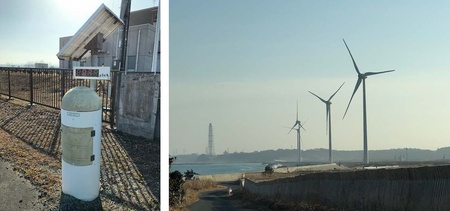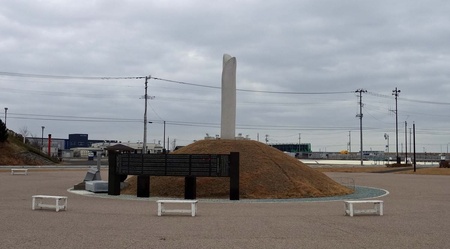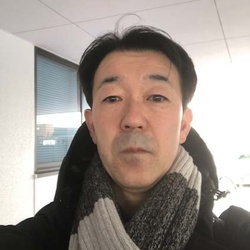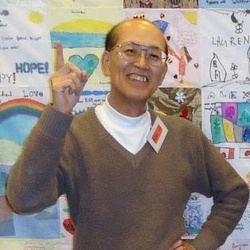This past Feb. 13th, there was a magnitude 7.1 earthquake in Fukushima. I froze. Cold sweat and a familiar sense of panic came raging back.
Flashback: March 11, 2011.
I clearly recall waking up for school and getting an odd, frantic phone call from CBC radio asking for a comment about the earthquake and tsunami in Japan. What the hell was going on? I wondered, annoyed by the early morning disruption. All morning at school, I was preoccupied by finding moments to check on the news out of Japan, specifically Tohoku and seeing terrifying images of black waves and swirling hellish waters carrying away whole houses in a flotsam of household goods and cars, surreal images of Sendai international airport submerged, and seeing hundreds of kilometers of Pacific coastline that I had travelled many times washed away in mere minutes. Phone lines and internet connections were down... power was out… recalling the magnitude 7.2 magnitude Hyogo-ken/Nanbu Earthquake that leveled much of Kobe occurred on Jan. 17th, 1995, killing 6,000… How were my Tohoku friends and family doing?
So, when Discover Nikkei's Yoko Nishimura recently asked me to put together some writing about the 10th anniversary of 3-11, I was initially surprised that so much time had passed by. As we are all dealing with the stresses and fears brought on by this Covid-19 pandemic and slow rollout of the vaccines, it is important to realize that there is hope.
Back in 2011, my main connections were filmmaker/artist Linda Ohama (Vancouver), Lorne Spry (Sendai), Tsutomu Nambu (Sendai), and Shogo Horiuchi (Minamisoma) in the ominous shadow of the Daiichi Nuclear Plant in Fukushima. The unfolding narrative, initially, anyways, was focussed on death and destruction and terror of another complete nuclear meltdown and Chernobyl-like catastrophe. Some brighter subplots (e.g., volunteerism) would reveal themselves later on but for the time being it was death, death, death, destruction, and a flurry of Youtube videos demonstrating nature’s furious and indiscriminate power.
Ah, 10 years later.... We do need to remember the survivors of 3-11, those who continue to stick it out in those coastal villages. Just as with the Covid-19 pandemic, it is tough to find anything sunny about something that is patently catastrophic and that which ravages the lives of the ‘most vulnerable’ as we like to say. As with any tragedy, the moral strength that rises in some is what I find most heartening.
Vancouver’s Linda Ohama rose up and organized a fundraiser in Vancouver to support the victims. She organized a quilt making project to support the kids there then, to top it off, she wrote and directed a documentary Tohoku no Sengetsu about the earthquake and tsunami survivors. Shogo Horiuchi’s family farm in Minamisoma, Fukushima was damaged by the flooding sea water. Lorne Spry and Tsutomu Nambu in Sendai suffered their own hells too.
The final 3-11 death toll of the magnitude 9-9.1 earthquake and tsunami was 15,897 and 2,527 who remain missing.
* * * * *
Lorne Spry (Sendai, Miyagi-ken)
What’s It Like 10 Years Later?
It is not easy to describe how one feels ten years after the ‘triple disaster’ of 2011. Most Tohoku residents remained safe. They endured sleepless nights and considerable inconveniences. But everyone knew that 20,000 people had been washed away by the sea, or buried under mud and debris. Everyone has been deeply affected. So today, those feelings are still raw both among people who escaped death and lost friends and family, as well as those of us who were less affected. A succinct answer to the question might well be this: some people are grieved and scarred by inconsolable loss, but all Tohoku people are a greater community that has been changed by the calamity. A bumper sticker reads in English, “The Spirit of Tohoku”. I have lived here for nearly thirty years as a foreign resident; I share the feelings — the spirit of Tohoku. Every anniversary fills me with great sadness, but hope for the future.
A decade has not seen a complete reconstitution of the region. Some people will never really recover — such as the old man who daily goes to the sea and calls out to his wife. Reconstruction is an ongoing industry. Periodically, volunteers search for the remains of 2,000 unaccounted for people. The remains of a woman were accidentally found only weeks ago. The Daiicihi Fukushima nuclear plant, which nearly caused the destruction of Japan, still poses problems for decommission. Viable solutions have not yet been devised. Moreover, we have been warned that another very severe quake could occur in Tohoku. This February, we had one that moved portions of a new seawall in a local fishing port. No one in Tohoku is left to just forget.

* * * * *
Shogo Horiuchi (Minamisoma, Fukushima-ken)
Does your brother still grow rice on your farm now?
No. My brother isn’t but my relatives are growing rice there now.
How have you and your family changed after 3-11?
My family’s daily life has become much more sensitive to disasters than it was before the disaster. Even now earthquakes often occur so we have begun to promptly confirm the safety of our family, relatives, and friends.
What do you want Canadians and Americans to know about 3-11 in 2021?
First of all, I want you to feel the importance of swift action to protect your life in the event of disaster. Second, I would like you to think more about the issue of nuclear power.

What is your future hope for Fukushima?
Early resolution of nuclear power problems. I wishIcould spend a quiet life in the future so that the place name Fukushima would be forgotten from the world.
Thank you for your support since the time of the earthquake. Thanks to everyone, we are able to recover little by little. Thank you very much. ARIGATO!

* * * * *
Tsutomu Nambu (Sendai, Miyagi-ken)
Reviewing 10 years After the Great East Japan Earthquake
The support we, as the people living in the affected areas, received from home and abroad both materially and mentally is something that I will never forget, especially now when I reflect on 10 years from the Great East Japan Earthquake.
I was really moved by fundraising activities which were started the day after the earthquake and which were done mainly by the Japanese Canadian groups across Canada. The Nikkei Voice conveyed what had been happening in Canada for Japan to me. In addition, Norm Ibuki, who has been my friend since 1997 when he was in Japan, sent an email to me writing about the ‘Ganbare Japan’ charity concert in Vancouver and a quilt message project both organized by Linda Ohama.
One day, I received another email from Norm saying that there was a person who was wanting to get Canadian elementary school students to create messages of support on quilt patches to send to the kids in the devastated areas. He said that Linda was scheduled to go to Natori, Miyagi in June and was there someone who could help her? I had to look for someone, because I lived in Fukushima at that time but it was in vain. In the end was me. It is a kind of curious twist of fate.
Linda was taking the quilt messages with her. She visited the disaster-stricken areas and developed rapport with the sufferers. And, moreover, she comforted them and encouraged them and gave them hope. They had lost their property and families and had no energy to live. She must have seemed like a Mother Teresa to them.
Finally, I would like to say thank you to Linda, Japanese Canadians, and all Canadians who still think of the survivors on behalf of the people living in the affected areas.

* * * * *
Linda Ohama (Vancouver, BC)
Time: 10 years ago. The 8-year-old boy Jushi from our film who was affected by the radiation is now 18 years old. The university student who lost her hometown in Iwate ken is now a kindergarten English teacher and about to be married.
My own reflections of my experiences with the Tohoku people is best expressed in their own recent messages. Hearing their own words is what we need to listen to. Through all their hardships and loss and determination, they always share so much love and kindness and thoughtfulness, which to me defines so much about the Tohoku people’s character. I am forever grateful to have so many obaachans, ojiichans, grandchildren, and friends in Tohoku from our time together and will always return to them often.
A letter from a young man who is from the Soma samurai lineage:
“This week, I was finally able to finish my evacuation life. Nine years and six months have passed since the evacuation caused by the Great East Japan Earthquake and the Fukushima Daiichi Nuclear Power Plant accident. The reconstruction of my home has just been completed, and I have resumed my life in my original home, Odaka-ku, Minamisoma (Fukushima).
“We have received a lot of encouragement and help from everyone from immediately after the evacuation life to today. Thank you very much. Thank you so much. When I evacuated, I thought I would either be able to return immediately or not forever.
“Supported by the government, countries around the world, Fukushima Prefecture, Minamisoma City, families, relatives, friends, people in the town, evacuees, restoration workers from all over the country, carpenters in new homes, etc. I’m here.
“The population is about 30 percent before the earthquake, and I feel some inconvenience in living in Odaka during the reconstruction, where still many dump trucks come and go every day, but I hope to make a new start and contribute to the reconstruction of the town in some way. I will. In the new home, have set up a dedicated space where you can easily gather. You can stay on the second floor as it is, so please feel free to drop by.”
Linda continues: After the recent earthquake on Feb. 13th, I received messages such as this:
“We are all safe, thank you. Some areas lost their lifelines including electricity and water supplies due to last night’s earthquake. The beeping alert sound tells of the coming massive earthquake from TV and iPhones kept ringing for a minute, falling books from the bookshelf, shakes like dizzy, the rumbling sound of the ground reminds me of the day in 2011 over again. We are about to have one decade from that day. This could be a message to us from the people taken by the 2011 disaster to tell us not to be lazy, be aware, be thankful and take action for the safety of everyone and, most of all, remember.”
*Linda’s 3-11 film, ‘Tohoku no Shingetsu’, made with the people of Tohoku, will be screened online by the Canadian Embassy Tokyo during the week prior to March 11, 2021.
© 2021 Norm Ibuki











